Unveiling the Diagenetic and Mineralogical Impact on the Carbonate Formation of the Indus Basin, Pakistan: Implications for Reservoir Characterization and Quality Assessment
Abstract
:1. Introduction
Geological Settings of the Study Area
2. Materials and Methods
2.1. Materials and Preparation of the Core Samples
2.2. Characterization Methods
2.3. Petrographic Analysis
2.4. Scanning Electron Microscope (SEM) and Energy Dispersive Spectroscopy (EDS) Analysis
2.5. FTIR Analysis
2.6. Petrophysical Measurements
2.7. Determination of Klinkenberg Permeability and Stress Sensitivity
3. Results and Discussion
3.1. Microfacies Analysis and Petrographic Description
3.2. Diagenesis and Identified Features
3.2.1. Micritization
3.2.2. Dissolution
3.2.3. Cementation
3.2.4. Compaction
3.2.5. Neomorphism
3.2.6. Dolomitization
3.3. Depositional Environment and Diagenetic History Reconstruction
3.4. Mineralogical Analysis
3.5. Petrophysical Measurements
3.6. Klinkenberg-Corrected Permeability and Gas Slippage Factor
3.7. Effect of Overburden Stress
4. Reservoir Quality Assessment
5. Conclusions
- The identified microfacies primarily consist of shallow to deep marine carbonate deposits ranging from packestone to grainstone, containing various micro and nano fossil assemblages. The particle size is predominantly fine-grained to medium, with euhedral to anhedral dolomite crystals, calcite cement, bioclasts associated with the micrite matrix, and clay minerals. This complex microfacies composition reflects the dynamic geologic history and depositional settings, representing the challenges in reservoir management and production.
- Several diagenetic processes, including micritization, cementation, and neomorphism, have had a detrimental impact on the reservoir quality during different diagenetic phases, such as marine, meteoric, and burial diagenesis. Conversely, dissolution, chemical compaction, and fracturing have enhanced the secondary porosity and permeability, which, in turn, are subsequently reduced by induced calcite cementation and the intermix of clay minerals, as described in Figure 5. This interplay of diagenetic processes significantly increases the reservoir heterogeneity, which ultimately affects the reservoir performance.
- The porosity and permeability values of the analyzed core samples ranged from 2.02% to 5.31% and 0.264 mD to 0.732 mD, with a standard deviation of 1.21, reflecting the formation’s heterogeneity. The packestone facies exhibit fair reservoir potential, while the grainstone facies show poor quality, indicating the presence of a complex pore throat structure.
- SEM, EDS, and FTIR analyses revealed that the formation predominantly contains calcite, dolomite, and huntite minerals, which have a strong affinity with grains and clay minerals, leading to precipitation and an increase in the reservoir heterogeneity.
- Overburden stress sensitivity testing exposed a substantial drop in the measured gas permeability ranges up to 22%–25%, with various gas slippage effects at lower pore pressures. This indicates that rock compaction due to the net confining stress tends to decrease in the primary porosity and permeability with an increase in the burial depth. Consequently, this highlighted the challenges in maintaining an effective fluid flow, resulting in the poor quality of the reservoir.
- These findings highlight the complex interplay of diagenetic processes, mineralogy, and overburden stress in determining the reservoir quality. The incorporation of these outcomes unveils the diagenetic and mineralogical complexities and heterogeneity of the reservoir matrix, thereby enhancing the reservoir characterization accuracy and quality assessment. Further, this study suggests certain limitations like sample size, spatial variability, fluid flow mechanisms, and mechanical properties for future studies. They should employ extended data collection, advanced imaging techniques, integrated reservoir simulation, field-scale validation, and economic analysis for the better prediction and optimization of reservoir behavior and help in decision making for reservoir development planning. This holistic approach opens the window for more effective exploration and exploitation strategies for carbonate reservoirs, highlighting the value of a multidisciplinary perspective in this complex geological domain. This will significantly aid in the development of indigenous resources in the region and contribute to global advancements in the field.
Author Contributions
Funding
Data Availability Statement
Acknowledgments
Conflicts of Interest
References
- Xia, L.-W.; Cao, J.; Wang, M.; Mi, J.-L.; Wang, T.-T. A review of carbonates as hydrocarbon source rocks: Basic geochemistry and oil–gas generation. Pet. Sci. 2019, 16, 713–728. [Google Scholar] [CrossRef]
- Medici, G.; Lorenzi, V.; Sbarbati, C.; Manetta, M.; Petitta, M.J.S. Structural classification, discharge statistics, and recession analysis from the springs of the Gran Sasso (Italy) carbonate aquifer; comparison with selected analogues worldwide. Sustainability 2023, 15, 10125. [Google Scholar] [CrossRef]
- Goldscheider, N.; Chen, Z.; Auler, A.S.; Bakalowicz, M.; Broda, S.; Drew, D.; Hartmann, J.; Jiang, G.; Moosdorf, N.; Stevanovic, Z.J.H.J. Global distribution of carbonate rocks and karst water resources. Hydrogeol. J. 2020, 28, 1661–1677. [Google Scholar] [CrossRef]
- Amjad, M.R.; Ehsan, M.; Hussain, M.; Al-Ansari, N.; Rehman, A.; Naseer, Z.; Ejaz, M.N.; Baouche, R.; Elbeltagi, A. Carbonate Reservoir Quality Variations in Basins with a Variable Sediment Influx: A Case Study from the Balkassar Oil Field, Potwar, Pakistan. ACS Omega 2023, 8, 4127–4145. [Google Scholar] [CrossRef] [PubMed]
- Daud, F.; Khan, G.N.; Ibrahim, M. Remaining hydrocarbon potential in Pakistan a statistical review. In Proceedings of the Society of Petroleum Engineers (SPE) Annual Technical Conference, Islamabad, Pakistan, 22–23 November 2011. [Google Scholar]
- Durrani, M.Z.A.; Talib, M.; Ali, A.; Sarosh, B.; Naseem, N. Characterization and probabilistic estimation of tight carbonate reservoir properties using quantitative geophysical approach: A case study from a mature gas field in the Middle Indus Basin of Pakistan. J. Pet. Explor. Prod. Technol. 2020, 10, 2785–2804. [Google Scholar] [CrossRef]
- Rashid, M.; Luo, M.; Ashraf, U.; Hussain, W.; Ali, N.; Rahman, N.; Hussain, S.; Aleksandrovich Martyushev, D.; Vo Thanh, H.; Anees, A. Reservoir Quality Prediction of Gas-Bearing Carbonate Sediments in the Qadirpur Field: Insights from Advanced Machine Learning Approaches of SOM and Cluster Analysis. Minerals 2022, 13, 29. [Google Scholar] [CrossRef]
- Cantrell, D.; Shah, R.; Ou, J.; Xu, C.; Phillips, C.; Li, X.; Hu, T. Depositional and diagenetic controls on reservoir quality: Example from the upper Cretaceous Mishrif Formation of Iraq. Mar. Pet. Geol. 2020, 118, 104415. [Google Scholar] [CrossRef]
- Hu, Y.; Guo, Y.; Qing, H.; Zhang, J. Diagenetic Control of Reservoir Performance and Its Implications for Reservoir Prediction in Jinci Sandstone of upper Carboniferous in the Middle East Ordos Basin. ACS Omega 2022, 7, 39697–39717. [Google Scholar] [CrossRef]
- Cipolla, C.L.; Lewis, R.E.; Maxwell, S.C.; Mack, M.G. Appraising unconventional resource plays: Separating reservoir quality from completion effectiveness. In Proceedings of International Petroleum Technology Conference; OnePetro: Richardson, TX, USA, 2011. [Google Scholar]
- Mahesar, A.A.; Shar, A.M.; Ali, M.; Tunio, A.H.; Uqailli, M.A.; Mohanty, U.S.; Akhondzadeh, H.; Iglauer, S.; Keshavarz, A. Morphological and petro physical estimation of eocene tight carbonate formation cracking by cryogenic liquid nitrogen; a case study of Lower Indus basin, Pakistan. J. Pet. Sci. Eng. 2020, 192, 107318. [Google Scholar] [CrossRef]
- Purdy, E.G. Carbonate Diagenesis: An Environmental Survey; Istituto di Geologia e Paleontologia dell’Università di Roma: Rome, Italy, 1968; pp. 183–228. [Google Scholar]
- Hewaidy, A.G.A.; Ayyad, H.M.; Abd El-Moghny, M.W.; Gameel, O.J.G.J. Sequence stratigraphy and biozonation of the Upper Eocene Anqabiya Formation, Gebel Anqabiya, Egypt. Geosci. J. 2019, 23, 357–375. [Google Scholar] [CrossRef]
- El Husseiny, A.; Vanorio, T.J.G. Porosity-permeability relationship in dual-porosity carbonate analogs. Geophys. J. 2017, 82, MR65–MR74. [Google Scholar] [CrossRef]
- Worden, R.; Armitage, P.; Butcher, A.; Churchill, J.; Csoma, A.; Hollis, C.; Lander, R.; Omma, J. Petroleum reservoir quality prediction: Overview and contrasting approaches from sandstone and carbonate communities. Geol. Soc. Lond. Spec. Publ. 2018, 435, 1–31. [Google Scholar] [CrossRef]
- Haile, B.; Klausen, T.; Czarniecka, U.; Xi, K.; Jahren, J.; Hellevang, H. How are diagenesis and reservoir quality linked to depositional facies? A deltaic succession, Edgeøya, Svalbard. Mar. Pet. Geol. 2018, 92, 519–546. [Google Scholar] [CrossRef]
- Beigi, M.; Jafarian, A.; Javanbakht, M.; Wanas, H.; Mattern, F.; Tabatabaei, A. Facies analysis, diagenesis and sequence stratigraphy of the carbonate-evaporite succession of the Upper Jurassic Surmeh Formation: Impacts on reservoir quality (Salman Oil Field, Persian Gulf, Iran). J. Afr. Earth Sci. 2017, 129, 179–194. [Google Scholar] [CrossRef]
- Javanbakht, M.; Wanas, H.; Jafarian, A.; Shahsavan, N.; Sahraeyan, M. Carbonate diagenesis in the Barremian-Aptian Tirgan Formation (Kopet-Dagh Basin, NE Iran): Petrographic, geochemical and reservoir quality constraints. J. Afr. Earth Sci. 2018, 144, 122–135. [Google Scholar] [CrossRef]
- Feng, T.; Feng, Y.; Tang, J.; Cui, Y.; Wang, B.; Peng, F.; Qin, D.; Zhang, Y. Diagenesis Sequence and Hydrocarbon Accumulation Period of the Ordovician Reservoir in Well Tashen-6, Tahe Oilfield, Tarim Basin, NW China. ACS Omega 2022, 7, 29420–29432. [Google Scholar] [CrossRef]
- Strasser, A.; Pittet, B.; Hillgärtner, H.; Pasquier, J.-B. Depositional sequences in shallow carbonate-dominated sedimentary systems: Concepts for a high-resolution analysis. Sediment. Geol. 1999, 128, 201–221. [Google Scholar] [CrossRef]
- Ali, S.A.; Clark, W.J.; Moore, W.R.; Dribus, J.R. Diagenesis and reservoir quality. Oilfield Rev. 2010, 22, 14–27. [Google Scholar]
- Ahmed, M.A.; Nasser, M.E.; Jawad, S.N.A. Diagenesis Processes Impact on Reservoir Quality in Carbonate Yamama Formation/Faihaa Oil Field. Iraqi J. Sci. 2020, 61, 92–102. [Google Scholar] [CrossRef]
- Palabiran, M.; Sesilia, N.; Akbar, M. An analysis of rock typing methods in carbonate rocks for better carbonate reservoir characterization: A case study of Minahaki Carbonate Formation, Banggai Sula Basin, Central Sulawesi. In Proceedings of the 41th Scientific Annual Meeting of Indonesian Association of Geophysicists (Pit Hagi) Lampung, (Aip Conference Proceedings), Lampung, Indonesia, 26–29 September 2016. [Google Scholar]
- Sun, H.; Vega, S.; Tao, G. Analysis of heterogeneity and permeability anisotropy in carbonate rock samples using digital rock physics. J. Pet. Sci. Eng. 2017, 156, 419–429. [Google Scholar] [CrossRef]
- Ahr, W.M. Geology of Carbonate Reservoirs: The Identification, Description and Characterization of Hydrocarbon Reservoirs in Carbonate Rocks; John Wiley & Sons: Hoboken, NJ, USA, 2011. [Google Scholar]
- Ayyad, H.M.; El-Moghny, M.W.A.; Abuseda, H.; Samir, A.; Bazeen, Y.S. Sequence stratigraphy and reservoir characterization of the lower Eocene rocks (Thebes Formation) along the Tethyan Ocean’s southern margin: Biostratigraphy and petrophysical parameter applications. Int. J. Earth Sci. 2023, 112, 1091–1112. [Google Scholar] [CrossRef]
- Boggs, S. Petrology of Sedimentary Rocks; Cambridge University Press: Cambridge, UK, 2009. [Google Scholar]
- Abro, W.A.; Shar, A.M.; Lee, K.S.; Narejo, A.A. An integrated analysis of mineralogical and microstructural characteristics and petrophysical properties of carbonate rocks in the lower Indus Basin, Pakistan. Open Geosci. 2019, 11, 1151–1167. [Google Scholar] [CrossRef]
- Shar, A.M.; Mahesar, A.A.; Chandio, A.D.; Memon, K.R. Impact of confining stress on permeability of tight gas sands: An experimental study. J. Pet. Explor. Prod. Technol. 2017, 7, 717–726. [Google Scholar] [CrossRef]
- Shafiee, M.; Kantzas, A. Investigation on the effect of overburden pressure on vuggy carbonate oil reservoir core properties. In Proceedings of the Canadian International Petroleum Conference, Calgary, AB, Canada, 16–18 June 2009. [Google Scholar]
- Khalid, P.; Farid, A.; Naseer, M.T.; Yasin, Q.; Naseem, S. Seismic stratigraphy and attributes application for imaging a Lower Cretaceous deltaic system: Sukkur rift zone, Lower Indus Basin, Pakistan. Mar. Pet. Geol. 2023, 149, 106030. [Google Scholar] [CrossRef]
- Wadood, B.; Ahmad, S.; Khan, S. Sedimentary microfacies analysis and reservoir characterization of the middle jurassic carbonates: A case study from lower Indus Basin, Pakistan. In Proceedings of the International Field Exploration and Development Conference 2018 8th; Springer: Singapore, 2018; pp. 1994–2000. [Google Scholar]
- Shah, S. Geological Survey of Pakistan. Stratigr. Pak. 2009, 22, 245–273. [Google Scholar]
- Ahmad, F.; Quasim, M.A.; Ahmad, A.H.M. Microfacies and diagenetic overprints in the limestones of Middle Jurassic Fort Member (Jaisalmer Formation), Western Rajasthan, India: Implications for the depositional environment, cyclicity, and reservoir quality. Geol. J. 2021, 56, 130–151. [Google Scholar] [CrossRef]
- Agar, S.M.; Geiger, S. Fundamental controls on fluid flow in carbonates: Current workflows to emerging technologies. Geol. Soc. Lond. Spec. Publ. 2015, 406, 1–59. [Google Scholar] [CrossRef]
- Wadood, B.; Khan, S.; Liu, Y.; Li, H.; Rahman, A. Investigating the impact of diagenesis on reservoir quality of the Jurassic shallow shelfal carbonate deposits: Kala Chitta Range, North Pakistan. Geol. J. 2021, 56, 1167–1186. [Google Scholar] [CrossRef]
- Ahmad, S.; Ahmad, F.; Ullah, A.; Eisa, M.; Ullah, F.; Kaif, K.; Khan, S. Integration of the outcrop and subsurface geochemical data: Implications for the hydrocarbon source rock evaluation in the Lower Indus Basin, Pakistan. J. Pet. Explor. Prod. Technol. 2019, 9, 937–951. [Google Scholar] [CrossRef]
- Khan, M.A.; Khan, T.; Ali, A.; Bello, A.M.; Radwan, A.E. Role of depositional and diagenetic controls on reservoir quality of complex heterogenous tidal sandstone reservoirs: An example from the Lower Goru formation, Middle Indus Basin, Southwest Pakistan. Mar. Pet. Geol. 2023, 154, 106337. [Google Scholar] [CrossRef]
- Memon, F.H.; Tunio, A.H.; Mahesar, A.A.; Abbas, G. Integrated Study to Assess the Diagenetic Impacts on Petro-Physical Characteristics and Reservoir Quality of Sukkur Rift Zone. J. Xi’an Shiyou Univ. 2023, 19, 1858–1865. [Google Scholar]
- Haris, M.; Ali, S.K.; Kazmi, S.U.; Ali, S.Z.; Zaheer, M.; Hussain, S.; Saad, K.; Islam, M.; Mehmood, T.; Humza, M. Surface and Subsurface Expressions of Jacobabad Khairpur Highs, Southern Indus Basin Using Well Data: An Approach For Well Prognosis. Int. J. Sci. Res. Publ. 2022, 12, 433–468. [Google Scholar] [CrossRef]
- Qayyum, F.; Hanif, M.; Mujtaba, M.; Wahid, S.; Ali, F. Evaluation of source rocks using one dimensional maturity modeling in Lower Indus Basin, Pakistan. Arab. J. Geosci. 2016, 9, 252–274. [Google Scholar] [CrossRef]
- Qureshi, M.A.; Ghazi, S.; Riaz, M.; Ahmad, S. Geo-seismic model for petroleum plays an assessment of the Zamzama area, Southern Indus Basin, Pakistan. J. Pet. Explor. Prod. 2021, 11, 33–44. [Google Scholar] [CrossRef]
- Zia, A.; Awais, M.; Ishaq, M.; Hamid, S.; Akhtar, N.; Sheikh, L. Application of well log Analysis to assess the petrophysical parameters of the early eocene Sui Main Limestone (SML) in Kharnhak-1 well, Middle Indus Basin, Pakistan. Iran. J. Oil Gas Sci. Technol. 2016, 5, 1–20. [Google Scholar]
- Siddiqui, N.K. Sui Main Limestone: Regional geology and the analysis of original pressures of a closed-system reservoir in central Pakistan. AAPG Bull. 2004, 88, 1007–1035. [Google Scholar] [CrossRef]
- Khan, U.; Du, J.; Hussain, S.; Jiang, Z.; Ali, S.; Ali, I.; Khan, M.; Zhang, B. Three-dimensional Structural Modeling (3D SM) and Joint Geophysical Characterization (JGC) of Hydrocarbon Reservoir. Minerals 2022, 12, 363. [Google Scholar] [CrossRef]
- Iqbal, M.; Nazeer, A.; Ahmad, H.; Murtaza, G. Hydrocarbon exploration perspective in Middle jurassic-early cretaceous reservoirs in the Sulaiman Fold Belt, Pakistan. In Proceedings of the PAPG/SPE Annual Technical Conference, Islamabad, Pakistan, 22–23 November 2011. [Google Scholar]
- Wandrey, C.J.; Law, B.; Shah, H.A. Sembar Goru/Ghazij Composite Total Petroleum system, Indus and Sulaiman-Kirthar Geologic Provinces, Pakistan and India; US Department of the Interior, US Geological Survey: Reston, VA, USA, 2004.
- Youssef, A.A.; Awotunde, A.A. Geosciences. Modelling fluid flow in karst reservoirs using Darcy Model with estimated permeability distribution. Comput. Geosci. 2019, 133, 104311. [Google Scholar] [CrossRef]
- Gao, H.; Li, H.A. Pore structure characterization, permeability evaluation and enhanced gas recovery techniques of tight gas sandstones. J. Nat. Gas Sci. Eng. 2016, 28, 536–547. [Google Scholar] [CrossRef]
- Mahesar, A.A.; Memon, K.R.; Tunio, A.H. Comparison of Klinkenberg-corrected gas and liquid permeability in Kirthar fold belt tight gas sands. Mehran Univ. Res. J. Eng. Technol. 2017, 36, 957–964. [Google Scholar] [CrossRef]
- Loeb, L.B. The Kinetic Theory of Gases; Courier Corporation: Washington, DC, USA, 2004. [Google Scholar]
- Liu, G.; Bai, Y.; Fan, Z.; Gu, D. Determination of Klinkenberg permeability conditioned to pore-throat structures in tight formations. Energies 2017, 10, 1575. [Google Scholar] [CrossRef]
- Al-Wardy, W.; Zimmerman, R.W. Effective stress law for the permeability of clay-rich sandstones. J. Geophys. Res. Solid Earth 2004, 109, 1–10. [Google Scholar] [CrossRef]
- Dunham, R.J. Classification of Carbonate Rocks according to Depositional Textures; Datapages, Inc.: Rockaway, NJ, USA, 1962. [Google Scholar]
- Bacelle, L.; Bosellini, A. Diagrams for visual estimation of percentage composition in sedimentary rocks [Diagrammi per la stima visiva della composizione percentualle nelle rocce sedimentarie]. Ann. Univ. Ferrara NS Sez. IX Sci. Geol. Paleont. 1965, 1, 59–62. [Google Scholar]
- Flügel, E.; Flügel, E. Fossils in thin section: It is not that difficult. In Microfacies of Carbonate Rocks: Analysis, Interpretation and Application; Springer: Berlin/Heidelberg, Germany, 2004; pp. 399–574. [Google Scholar]
- Cheema, A.H. Microfacies, Diagenesis and Depositional Environments of Samana Suk Formation (Middle Jurassic) Carbonates Exposed in South East Hazara and Samana Range. Ph.D. Thesis, University of the Punjab, Lahore, Pakistan, 2010. [Google Scholar]
- Mohamed, A.A.I.; Belhaj, H.; Gomes, J.S.; Bera, A. Petrographic and diagenetic studies of thick transition zone of a middle-east carbonate reservoir. J. Pet. Gas Eng. 2017, 8, 1–10. [Google Scholar]
- Zhao, H.; Liang, B.; Sun, W.; Hu, Z.; Sun, J.; Hao, J.; Liu, Q. Experimental Study on the Effects of Pore Pressure and Slippage on the Permeability of a Fracture Network during Depressurization of Shale Gas Reservoir Production. ACS Omega 2022, 7, 13644–13653. [Google Scholar] [CrossRef] [PubMed]
- Shar, A.M.; Mahesar, A.A.; Abbasi, G.R.; Narejo, A.A.; Hakro, A.A.A.D. Influence of diagenetic features on petrophysical properties of fine-grained rocks of Oligocene strata in the Lower Indus Basin, Pakistan. Open Geosci. 2021, 13, 517–531. [Google Scholar] [CrossRef]
- Abuseda, H.; Kassab, M.A.; LaLa, A.M.; El Sayed, N.A. Integrated petrographical and petrophysical studies of some Eocene carbonate rocks, Southwest Sinai, Egypt. Egypt. J. Pet. 2015, 24, 213–230. [Google Scholar] [CrossRef]
- Caron, V. Petrogenesis of Pliocene Limestones in Southern Hawke’s Bay, New Zealand: A Contribution to Unravelling the Sequence Stratigraphy and Diagenetic Pathways of Cool-Water Shelf Carbonate Facies. Ph.D. Thesis, The University of Waikato, Hamilton, New Zealand, 2002. [Google Scholar]
- Swei, G.; Tucker, M.E. Impact of diagenesis on reservoir quality in ramp carbonates: Gialo Formation (Middle Eocene), Sirt Basin, Libya. J. Pet. Geol. 2012, 35, 25–47. [Google Scholar] [CrossRef]
- Ehrenberg, S.; Eberli, G.; Keramati, M.; Moallemi, S. Porosity-permeability relationships in interlayered limestone-dolostone reservoirs. AAPG Bull. 2006, 90, 91–114. [Google Scholar] [CrossRef]
- Ahmed, S.; Solangi, S.H.; Jadoon, M.S.K.; Nazeer, A. Tectonic evolution of structures in Southern Sindh Monocline, Indus Basin, Pakistan formed in multi-extensional tectonic episodes of Indian Plate. Geod. Geodyn. 2018, 9, 358–366. [Google Scholar] [CrossRef]
- Haq, B.U.; Hardenbol, J.; Vail, P.R. Chronology of fluctuating sea levels since the Triassic. Science 1987, 235, 1156–1167. [Google Scholar] [CrossRef] [PubMed]
- Flügel, E.; Munnecke, A. Microfacies of Carbonate Rocks: Analysis, Interpretation and Application; Springer: Berlin/Heidelberg, Germany, 2010; Volume 976. [Google Scholar]
- Flügel, E. Microfacies Analysis of Limestones; Springer Science & Business Media: Berlin/Heidelberg, Germany, 2012. [Google Scholar]
- Tavakoli, V.; Rahimpour-Bonab, H.; Esrafili-Dizaji, B. Diagenetic controlled reservoir quality of South Pars gas field, an integrated approach. Comptes Rendus Geosci. 2011, 343, 55–71. [Google Scholar] [CrossRef]
- Lee, Y.I.; Friedman, G.M. Deep-burial dolomitization in the Ordovician Ellenburger Group carbonates, west Texas and southeastern New Mexico. J. Sediment. Res. 1987, 57, 544–557. [Google Scholar]
- Deelman, J. Magnesite and Huntite. Low–Temperature Formation of Dolomite and Magnesite. 2011. Available online: http://www.jcdeelman.demon.nl/dolomite/files/13_Chapter6.pdf (accessed on 12 March 2014).
- Stanienda-Pilecki, K.J. The importance of Fourier-Transform Infrared Spectroscopy in the identification of carbonate phases differentiated in magnesium content. Spectroscopy 2019, 34, 32–42. [Google Scholar]
- Sakai, S.; Yang, D.; Yasuda, T.; Akiyama, K.; Kuga, T.; Kano, A.; Shiraishi, F.; Amekawa, S.; Ohtsuka, S.; Nakaguchi, K. Pulsed terahertz radiation for sensitive quantification of carbonate minerals. ACS Omega 2019, 4, 2702–2707. [Google Scholar] [CrossRef] [PubMed]
- Abbas, G.; Tunio, A.H.; Memon, K.R.; Mahesar, A.A.; Memon, F.H.; Abbasi, G.R. Modification of cellulose ether with organic carbonate for enhanced thermal and rheological properties: Characterization and analysis. ACS Omega 2023, 8, 25453–25466. [Google Scholar] [CrossRef]
- Klinkenberg, L. The Permeability Porous Media to Liquids Gases; American Petroleum Institute Drilling and Production-Practice: Washington, DC, USA, 1941. [Google Scholar]
- Zou, J.; Yue, X.; An, W.; Gu, J.; Wang, L. Applicability analysis of klinkenberg slip theory in the measurement of tight core permeability. Energies 2019, 12, 2351. [Google Scholar] [CrossRef]
- Memon, K.R.; Ali, M.; Awan, F.U.R.; Mahesar, A.A.; Abbasi, G.R.; Mohanty, U.S.; Akhondzadeh, H.; Tunio, A.H.; Iglauer, S.; Keshavarz, A. Influence of cryogenic liquid nitrogen cooling and thermal shocks on petro-physical and morphological characteristics of Eagle Ford shale. J. Nat. Gas Sci. Eng. 2021, 96, 104313. [Google Scholar] [CrossRef]
- Memon, K.R.; Mahesar, A.A.; Ali, M.; Tunio, A.H.; Mohanty, U.S.; Akhondzadeh, H.; Awan, F.U.R.; Iglauer, S.; Keshavarz, A. Influence of cryogenic liquid nitrogen on petro-physical characteristics of mancos shale: An experimental investigation. Energy Fuels 2020, 34, 2160–2168. [Google Scholar] [CrossRef]
- Mahesar, A.A.; Ali, M.; Shar, A.M.; Memon, K.R.; Mohanty, U.S.; Akhondzadeh, H.; Tunio, A.H.; Iglauer, S.; Keshavarz, A. Effect of cryogenic liquid nitrogen on the morphological and petrophysical characteristics of tight gas sandstone rocks from kirthar fold belt, Indus Basin, Pakistan. Energy Fuels 2020, 34, 14548–14559. [Google Scholar] [CrossRef]

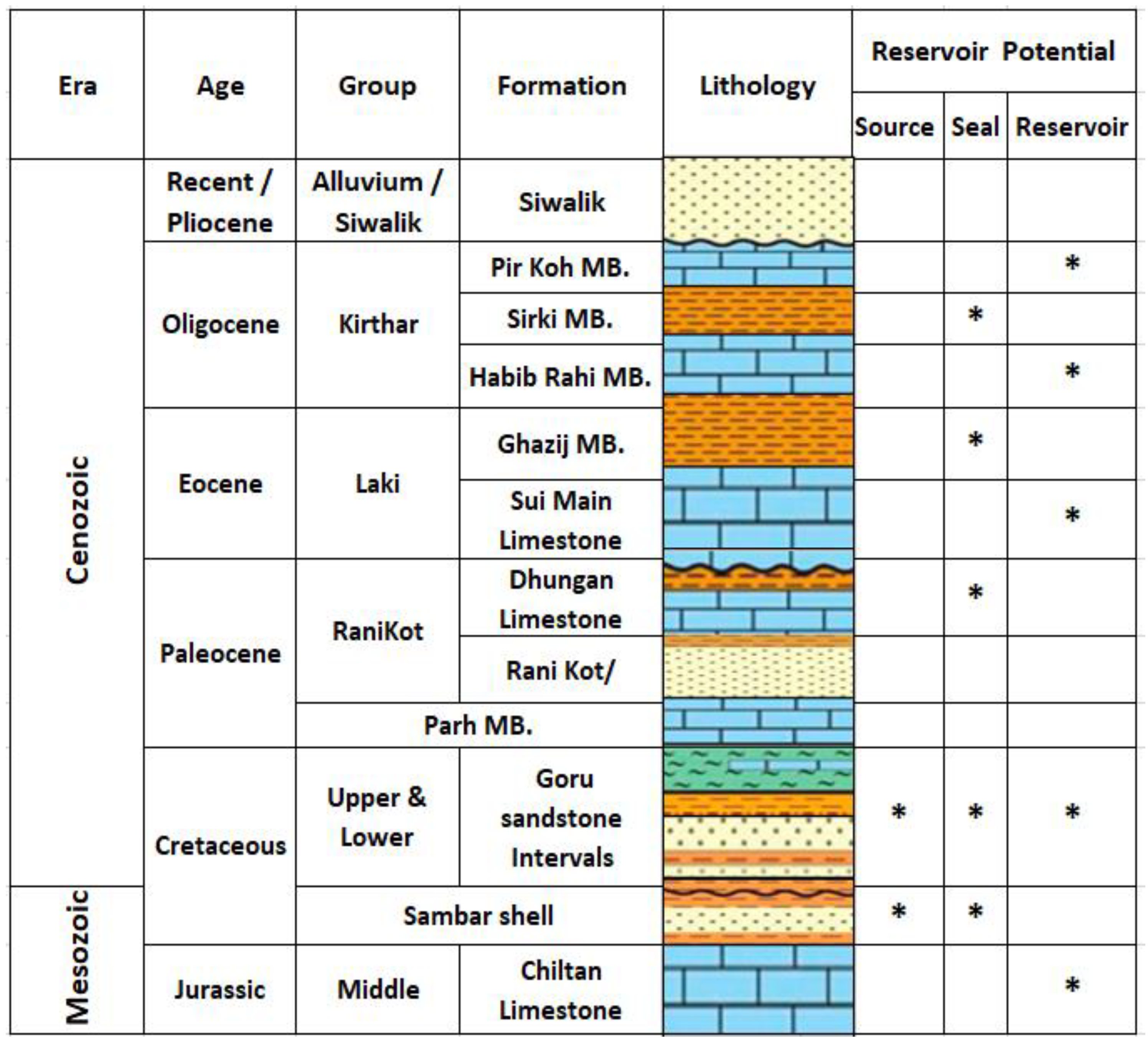

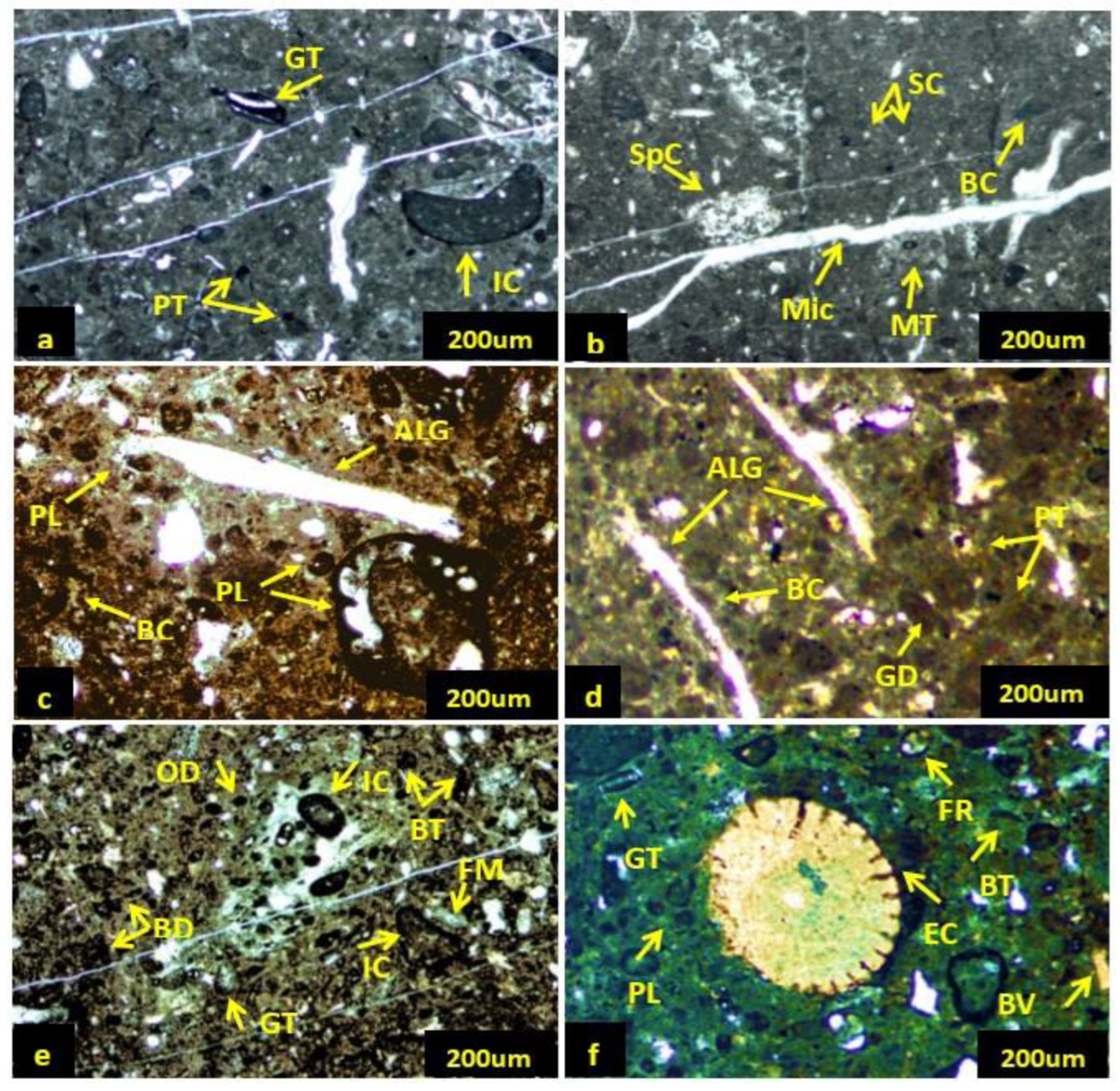

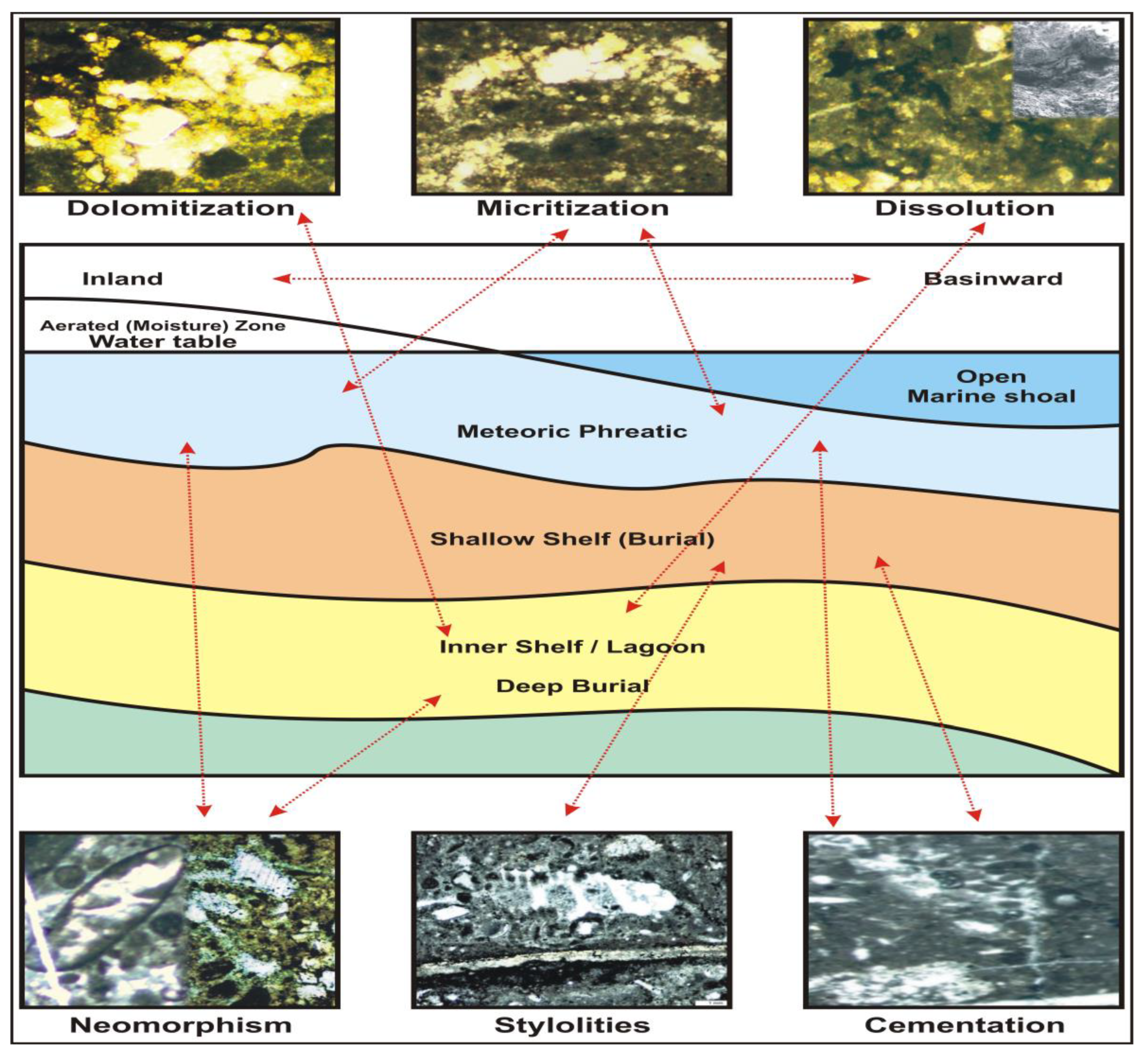
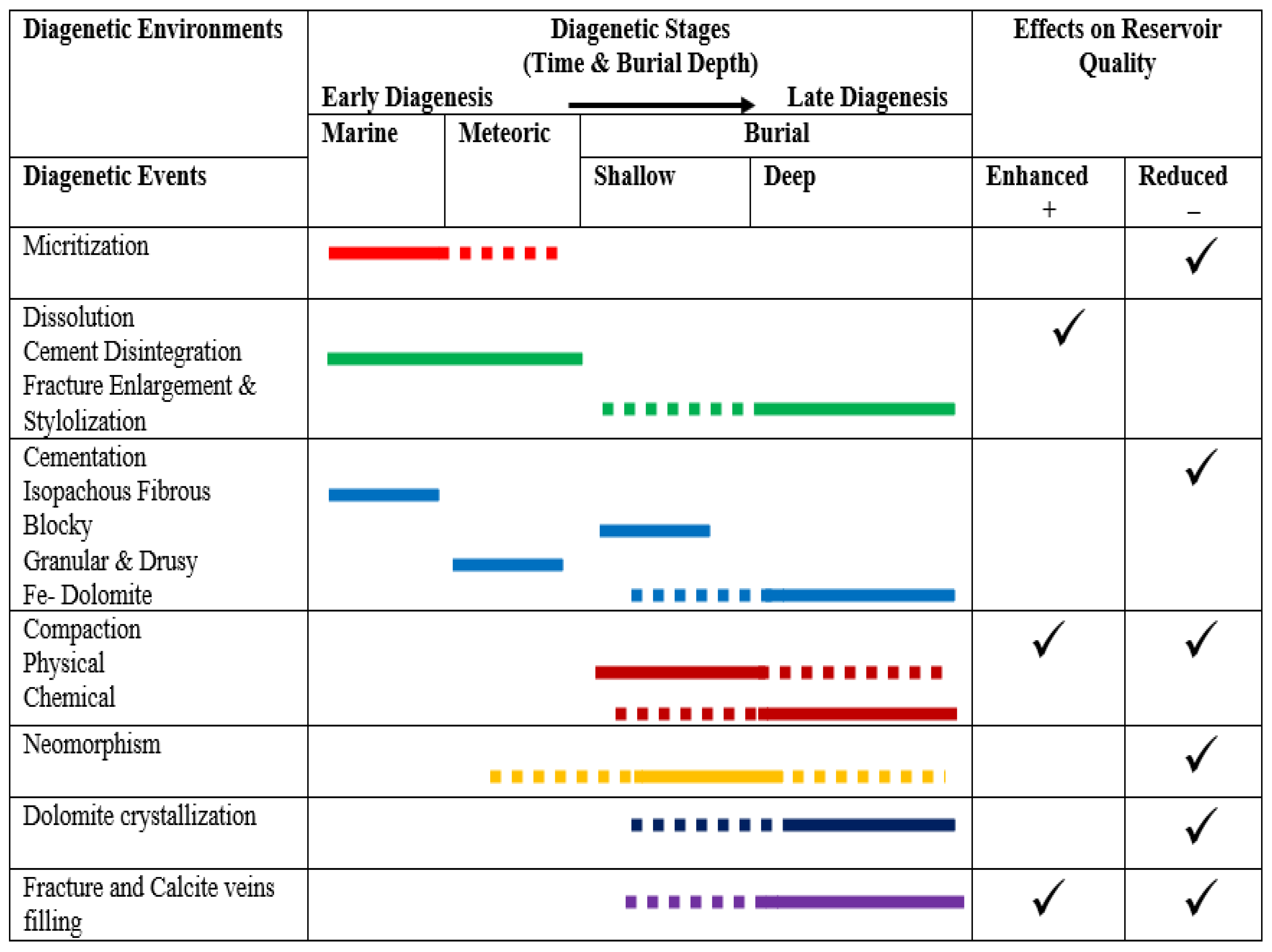

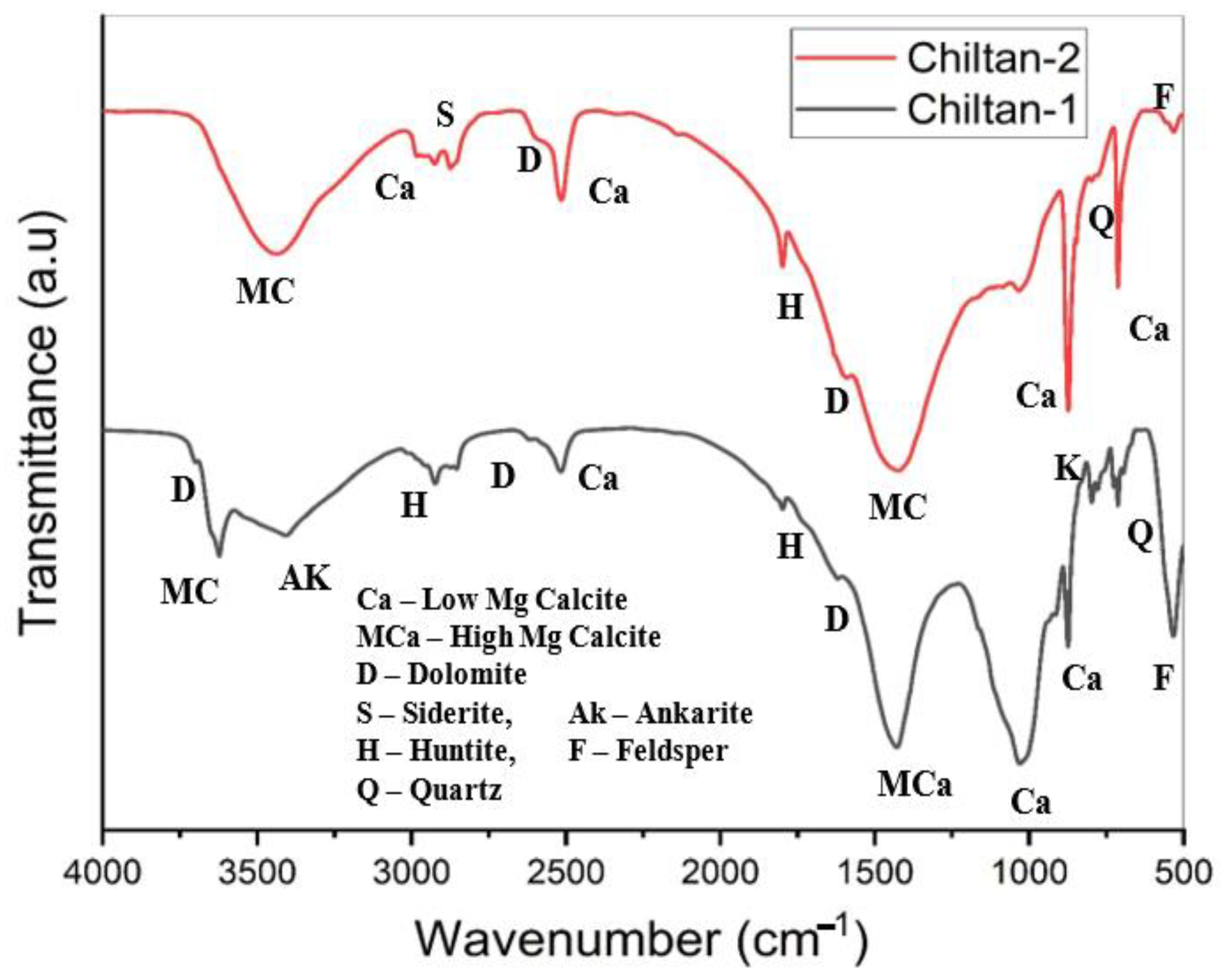
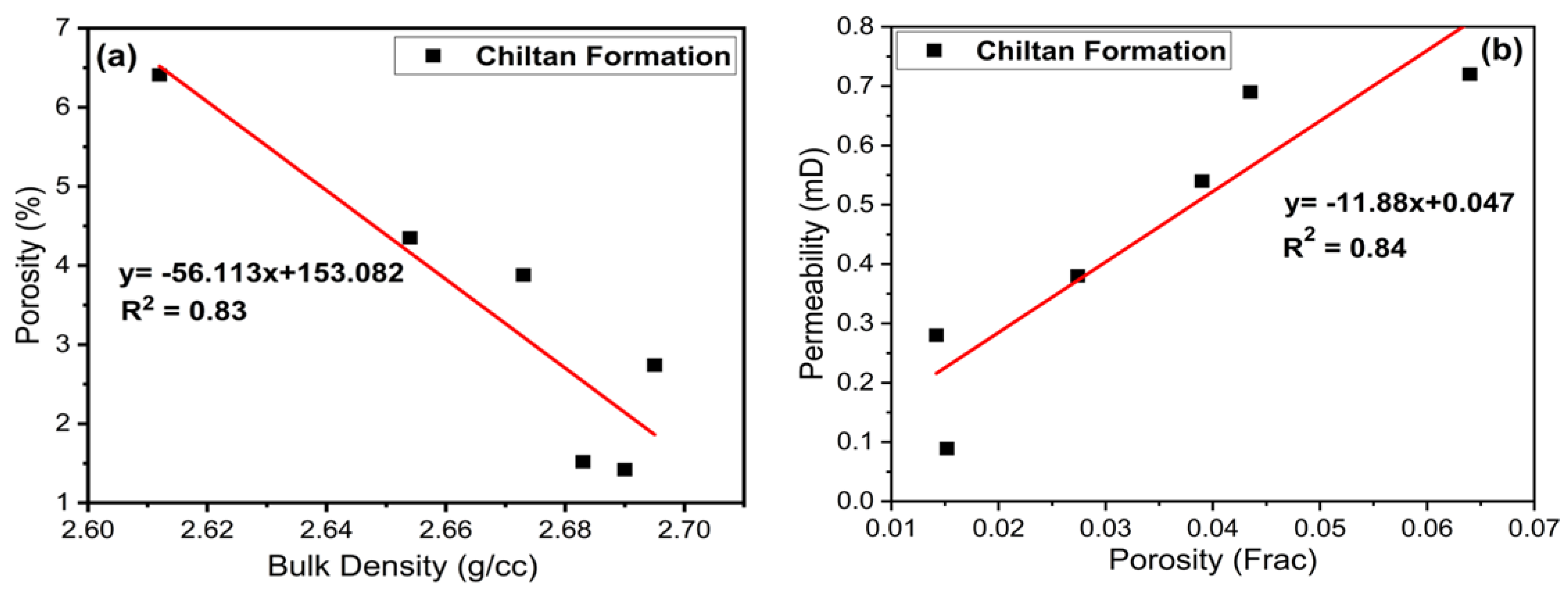
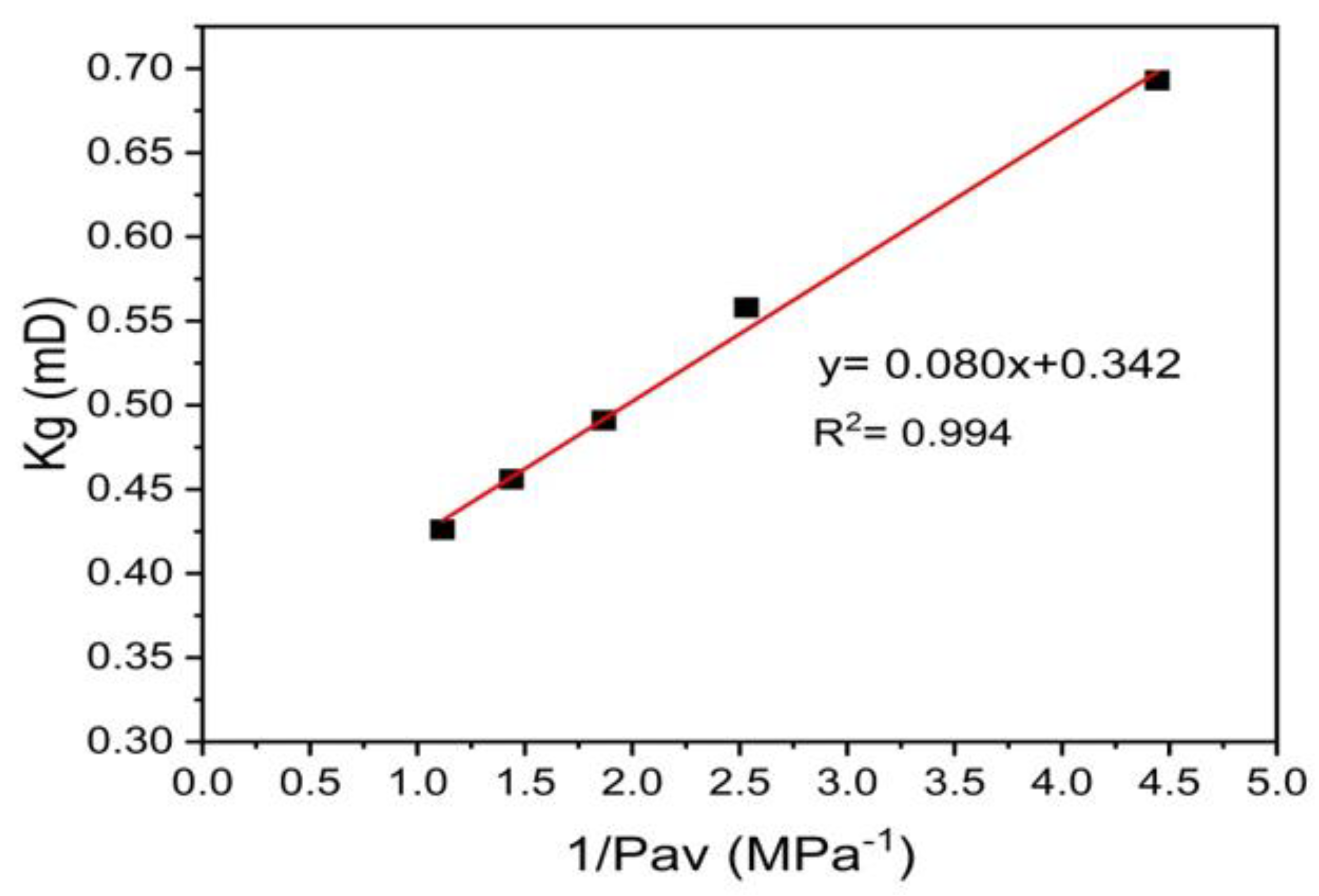


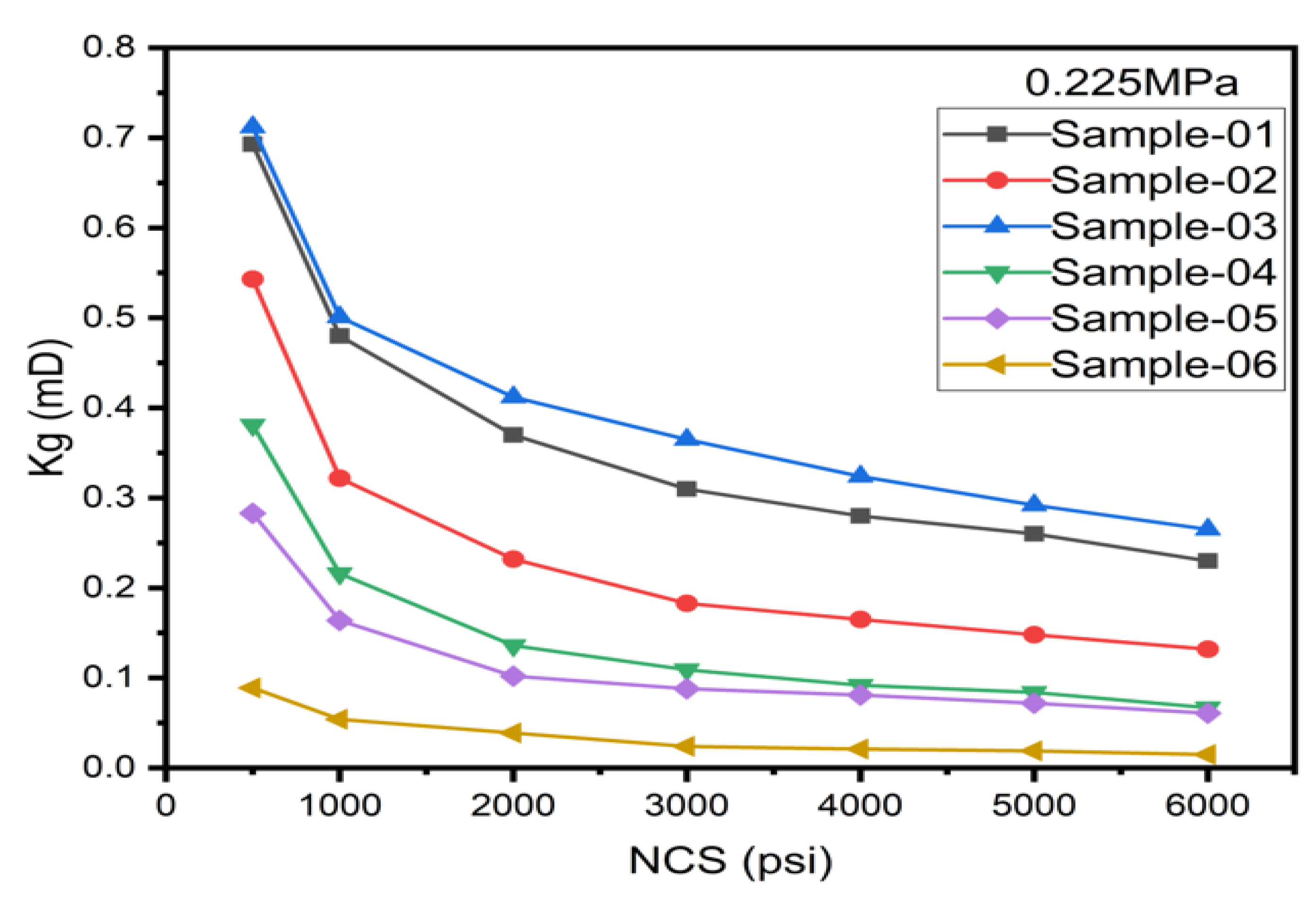

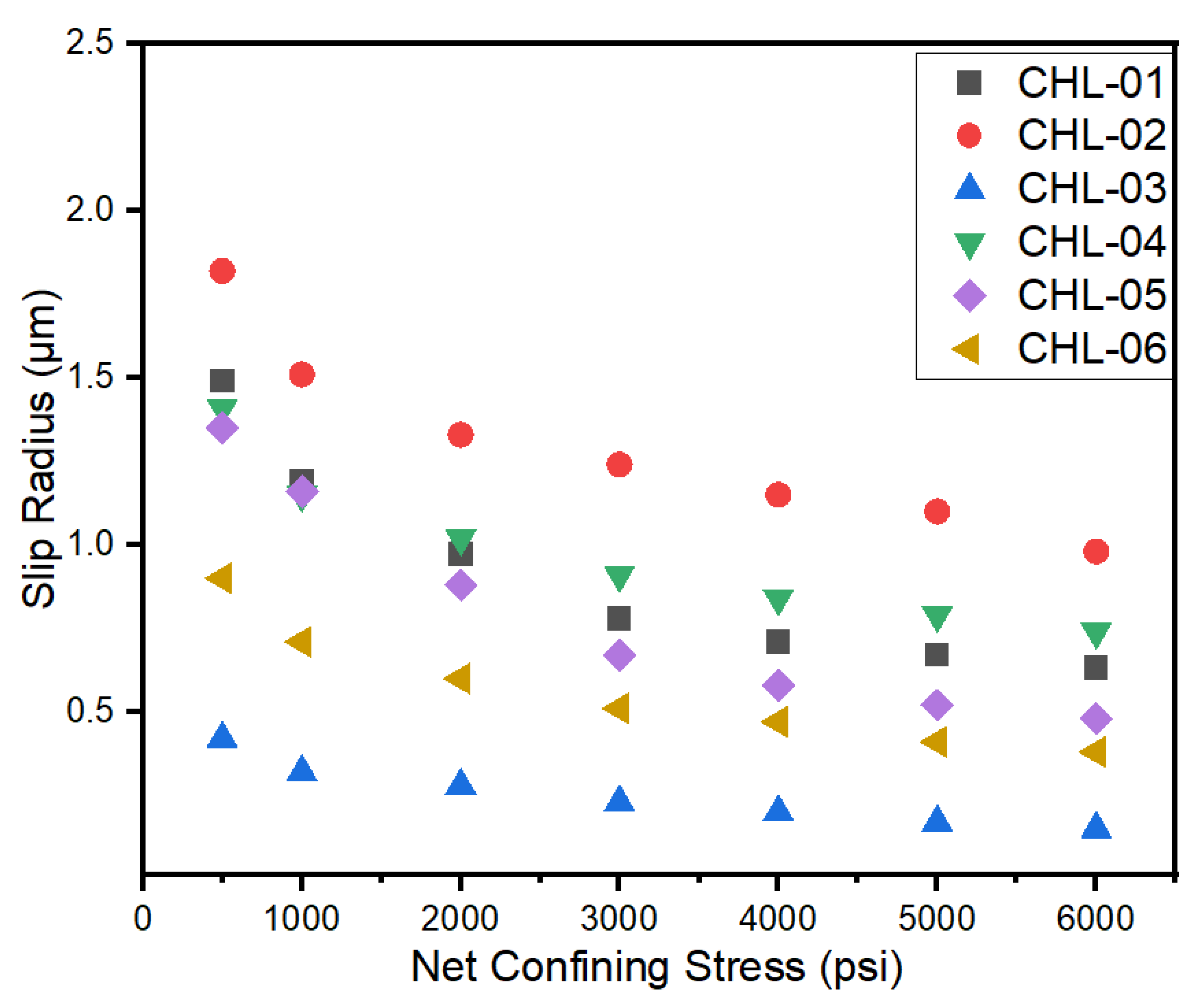
| Microfacies | Carbonate Grains | Cement | Estimated Visual Porosity (Thin Section) | Dominant Pore Type | Diagenetic Features | Depositional Environment | |||
|---|---|---|---|---|---|---|---|---|---|
| Lithology | Bio-Clasts % | Intraclasts/Echinoderm % | Peloids/Ooids % | Calcite % | Micrite % | ||||
| Intra-clastic Ooidal packestone | 05% | 20% | 10% | 35% | 25% | Bad porosity up-to 5% | Primary porosity is limited. Secondary porosity is developed by stylolization. | Intra-Formational Clasts, Calcite veins, Neomorphism stylolization | Shoal |
| Bioclastic grainstone | 25% | 25% | 15% | 20% | 13% | Bad porosity up-to 2%–3% | Primary porosity is limited. Secondary porosity developed due to grain dissolution. | Calcite vein, Cementation, Dissolution, Dolomitization | Lagoon |
| Pelliodal Packestone | 15% | 05% | 15% | 40% | 20% | Bad porosity up-to 2%–5% | Primary porosity is limited. Secondary porosity developed due to grain dissolution. | Calcite vein, Cementation, Dissolution, Dolomitization | Lagoon |
| Element | Atomic No. | Mass Norm. % | Weight, % |
|---|---|---|---|
| Oxygen | 8 | 50.90 | 71.46 |
| Calcium | 20 | 42.09 | 23.59 |
| Iron | 26 | 1.92 | 0.77 |
| Aluminum | 13 | 0.94 | 0.78 |
| Silicon | 14 | 2.86 | 2.29 |
| Sulphur | 16 | 0.43 | 0.30 |
| Magnesium | 12 | 0.57 | 0.53 |
| Sodium | 11 | 0.28 | 0.28 |
| Sample ID | Parameters | Mean Pore Pressure | Klinkenberg Permeability (mD) | ||||
|---|---|---|---|---|---|---|---|
| 0.225 | 0.395 | 0.535 | 0.695 | 0.895 | |||
| 23-CHL-01 | Gas Permeability (Kg), mD | 0.693 | 0.558 | 0.491 | 0.45 | 0.426 | 0.343 |
| Slip radius (rslip), µm | 1.5 | 1.39 | 1.49 | 1.59 | 1.59 | ||
| Gas slip factor (bk), psi | 14.01 | 26.52 | 33.49 | 40.78 | 52.56 | ||
| 23-CHL-2A | Gas Permeability (Kg), mD | 0.543 | 0.41 | 0.322 | 0.289 | 0.257 | 0.168 |
| Slip radius (rslip), µm | 0.68 | 0.6 | 0.7 | 0.69 | 0.72 | ||
| Gas slip factor (bk), psi | 30.64 | 60.94 | 71.14 | 94.32 | 115.06 | ||
| 23-CHL-03 | Gas Permeability (Kg), mD | 0.089 | 0.059 | 0.042 | 0.036 | 0.031 | 0.011 |
| Slip radius (rslip), µm | 0.21 | 0.2 | 0.22 | 0.21 | 0.21 | ||
| Gas slip factor (bk), psi | 175.2 | 184.6 | 218.72 | 236.7 | 246.3 | ||
| 23-CHL-4B | Gas Permeability (Kg), mD | 0.712 | 0.502 | 0.408 | 0.341 | 0.273 | 0.153 |
| Slip radius (rslip), µm | 0.41 | 0.38 | 0.38 | 0.4 | 0.48 | ||
| Gas slip factor (bk), psi | 50.15 | 96.5 | 129.36 | 160.94 | 170.36 | ||
| 23-CHL-05 | Gas Permeability (Kg), mD | 0.381 | 0.251 | 0.173 | 0.149 | 0.112 | 0.027 |
| Slip radius (rslip), µm | 0.12 | 0.1 | 0.19 | 0.11 | 0.12 | ||
| Gas slip factor (bk), psi | 179.18 | 185.7 | 190.3 | 204.5 | 210.4 | ||
| 23-CHL-06 | Gas Permeability (Kg), mD | 0.283 | 0.186 | 0.132 | 0.112 | 0.095 | 0.032 |
| Slip radius (rslip), µm | 0.19 | 0.18 | 0.21 | 0.2 | 0.19 | ||
| Gas slip factor (bk), psi | 107.67 | 243.6 | 242.54 | 251.2 | 263.1 | ||
Disclaimer/Publisher’s Note: The statements, opinions and data contained in all publications are solely those of the individual author(s) and contributor(s) and not of MDPI and/or the editor(s). MDPI and/or the editor(s) disclaim responsibility for any injury to people or property resulting from any ideas, methods, instructions or products referred to in the content. |
© 2023 by the authors. Licensee MDPI, Basel, Switzerland. This article is an open access article distributed under the terms and conditions of the Creative Commons Attribution (CC BY) license (https://creativecommons.org/licenses/by/4.0/).
Share and Cite
Memon, F.H.; Tunio, A.H.; Memon, K.R.; Mahesar, A.A.; Abbas, G. Unveiling the Diagenetic and Mineralogical Impact on the Carbonate Formation of the Indus Basin, Pakistan: Implications for Reservoir Characterization and Quality Assessment. Minerals 2023, 13, 1474. https://doi.org/10.3390/min13121474
Memon FH, Tunio AH, Memon KR, Mahesar AA, Abbas G. Unveiling the Diagenetic and Mineralogical Impact on the Carbonate Formation of the Indus Basin, Pakistan: Implications for Reservoir Characterization and Quality Assessment. Minerals. 2023; 13(12):1474. https://doi.org/10.3390/min13121474
Chicago/Turabian StyleMemon, Faisal Hussain, Abdul Haque Tunio, Khalil Rehman Memon, Aftab Ahmed Mahesar, and Ghulam Abbas. 2023. "Unveiling the Diagenetic and Mineralogical Impact on the Carbonate Formation of the Indus Basin, Pakistan: Implications for Reservoir Characterization and Quality Assessment" Minerals 13, no. 12: 1474. https://doi.org/10.3390/min13121474






